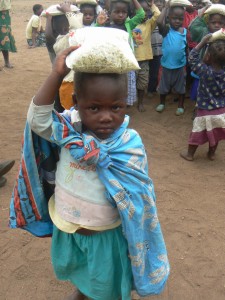Ntcheu, Malawi … “The price of maize has more than doubled in recent months, and families are lucky to eat even once a day. Children are greatly affected! There is growing fear of high malnutrition among children of less than 5, as well as with women. Children are boiling and eating small green mango fruit for some nutritional value,” reported village headman Nkonde told the crowd as he witnessed the food distribution exercise. He made note that in the past the community could contribute food to feed the children in Child Based Care Centers (CBCCs), but this year they can’t. There is no food.
Nkonde is a tribal leader in the Ntcheu District of Malawi. It is one of the 15 most seriously affected districts. Wilson Tembo, Director of Distribution for the Malawi Project noted, “In our recent food distribution to children, it was evident the food crisis is more serious than I ever imagined. At one of the distribution sites I saw children less than 6 years of age whose faces spoke more words than their mouths could speak. They were miserable and weak. At this particular distribution we were able to give food to 640 children.”
After nine years of relative food security the 2014-15 planting season first experienced an absence of rain, then torrential flooding washed away crops. By then it was too late to replant. According to the Malawi Vulnerability Assessment Committee (MVAC), 64,000 hectares of crop fields mostly in the south were washed away. This resulted in 15 of the 28 districts being heavily affected by the food shortage. According to the Malawi Vulnerability Assessment Committee (MVAC), 2,833,212 people will have little or no food from now until the next harvest five months from now.
The Malawi Project, and its supporters have made possible two trailers of food assistance in recent weeks. It is hoped that additional food shipments can be sent before the next harvest offers some relief from the shortage.


